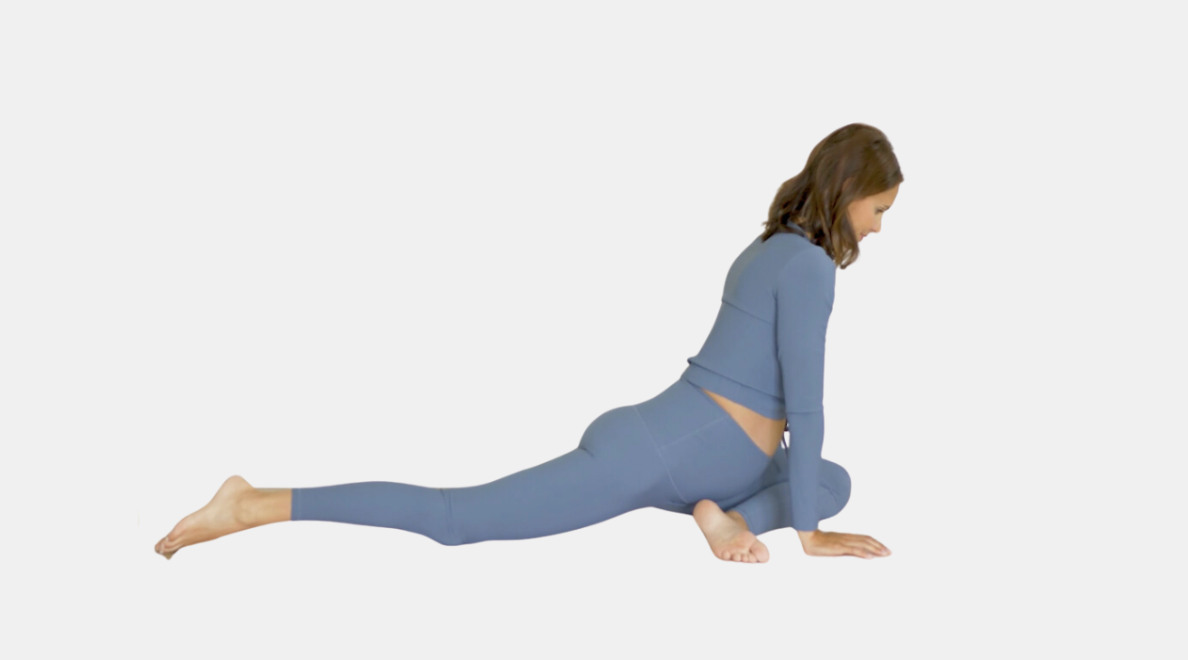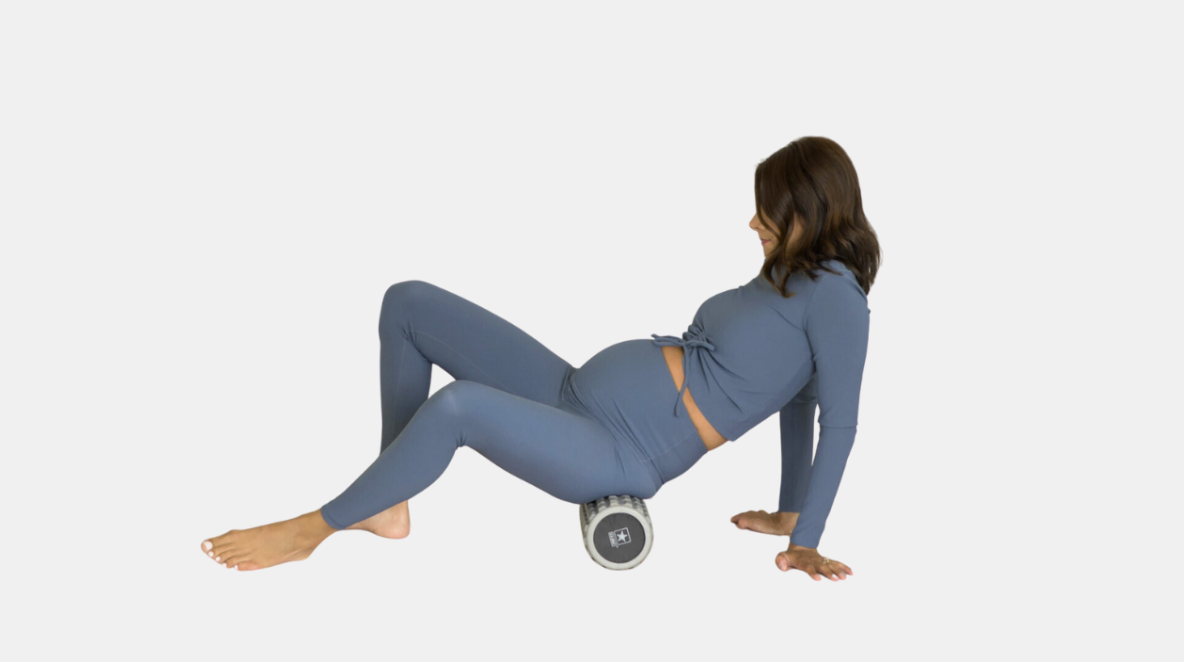Sciatica Pain in Pregnancy - What to do to feel better
The Sciatica nerve runs from your lower back to your feet. Sciatica pain in pregnancy is when the sciatic nerve is irritated or compressed.
If you have sciatica pain in pregnancy, there are certain exercises you might find uncomfortable or want to avoid completely. In this article, I’ll share everything you need to know about sciatic nerve pain in pregnancy, including how you know if you have it and the best stretches to relieve the pain.
Sciatic Pain During Pregnancy
The sciatic nerve is the biggest, thickest, and longest nerve in your body. It runs from your lower back and spine through the hips and bottom, branching down each leg.
When you’re pregnant, your ligaments loosen, your center of gravity shifts, and your belly grows. All of these factors can cause pinching or irritation in the sciatic nerve.
If this nerve is irritated or pinched, it can cause shooting pain down the buttocks and back of one of your legs, though sometimes it can be in both. Other signs you may have sciatic pain during pregnancy include:
Tingling
Numbness
Weakness
Low back pain
You may experience these issues in the legs, toes, or buttocks.
How do you know if it's sciatic pain or something else?
Sciatic pain in pregnancy is often mistaken for pelvic pain. It’s important to understand which pain you have so you perform the right stretches to relieve rather than aggravate.
There are two self-tests you can do at home to see if your pain is sciatic pain.
Test 1
Sit on a chair with your feet flat on the floor
Drop your chin to your chest
Lift one leg off the floor and extend the leg, keeping your foot flexed
If you experience pain the back of your leg, this is sciatic pain
Try lifting the neck and looking up, if the pain reduces this is a sign it was sciatica pain
Test two
From standing, bend forward, keeping your legs straight with a slight bend in the knees
If you feel pain down the back of one leg, this is sciatica pain
If the pain is in your lower back, it is likely not sciatic pain
Sciatic pregnancy stretches
Sciatica pregnancy stretches can offer some relief from the pain. Here are six stretches if you’re looking for how to ease sciatica pregnancy.
Towel Pull
The towel pull is a great stretch for sciatica pain in pregnancy that you can do anywhere, anytime.
Kneel or stand
Wrap a towel or belt around your low back
Gently round your back backwards as you pull the towel forward
Only bend your back slightly to not overstretch your core
Try bringing your hands up by your shoulders to increase the stretch
Repeat 10 times
Nerve Glide
The Nerve Glide stretch is also known as sciatic nerve flossing. The gentle stretch helps mobilize the sciatic nerve and ease the pain.
Lie on the floor with your legs extended and arms straight
Bend the knee of the affected leg and bring it towards your chest
Place your hand behind your thigh to support the leg
Slowly straighten your leg towards the ceiling until you feel the stretch in the back of your leg
When you’re ready, slowly flex the foot to extend the stretch and increase the tension in the nerve
If you feel sharp pain, stop. It should be a mild stretch that tingles slightly, but it shouldn’t be painful. Bend the knee to reduce the intensity and then go back into the stretch when you feel ready. Continue bending and extending the leg slowly and with control. Do this for 30 seconds on each side.
90/90 Stretch
The 90/90 stretch helps to mobilise the hip.
Sit on the floor with one leg in front with the knee bent at 90 degrees
The other leg behind you is bent at 90 degrees
Keep your torso upright, straighten your back, and then slowly lean forward as much as you can without rounding your back
Feel a stretch in your outer hip and glute
Hold for 30 seconds, then swap sides
Pigeon Pose
The pigeon pose may feel difficult at first. However, over time, you should be able to get deeper into it.
Bend your front leg and move your foot to the side
Your knee should be between your hands
Your other leg extends backwards, and your foot rests on the mat
Ensure that your weight stays in the middle of your body and that you are not opening your hip or sitting only on one side.
Hold for 30 seconds, then switch sides.
Seated Piriformis Stretch
The seated piriformis stretch helps relieve sciatic pain in pregnancy by stretching the piriformis.
Sit on a chair with your feet flat on the floor
Place your right ankle on your left knee
Keep your back straight, gently lean forward from the hips, bringing your chest toward your legs
Hold the stretch for 20-30 seconds, feeling a stretch in the right glute and hip
Switch sides and repeat with the left leg
Foam Rolling Massage
A foam rolling massage helps relieve tension in the muscles surrounding the sciatic nerve. If you don’t have a foam roller, you can also use a tennis ball.
Place the foam roller on the floor and sit on it with your knees bent and your hands on the floor behind you for support
Move the foam roller to one side and shift your weight onto that side
Slowly roll back and forth, and focus on the area you feel tension
Roll over the back of your thigh and glute
Pause and hold the pose on tender spots to allow the muscle to release
Spend 1-2 minutes on each side
I also have a great follow along exercise video on my YouTube channel to relieve sciatica pain during pregnancy.
How to reduce sciatic nerve pain during pregnancy: Daily tips
You should carry on with your normal activities as much as you can when you have sciatica pain in pregnancy. There are a few adjustments and things you can do to ease the daily pain.
Gentle exercise and movement can be good for sciatica. Try the stretches mentioned above or other exercises that feel comfortable. Movement might be painful, but it can help you get better sooner. You should avoid sitting for long periods as this can make things feel worse.
Heat packs or a heating pillow can help ease painful areas. Avoid putting anything too hot on the area, as this can scald your skin if your leg is numb. When sleeping on your side, put a small cushion between your knees and ankles.
If you’re not sure which exercise you can do during pregnancy when you have sciatica, have a look at my pregnancy fitness program BUMP. This workout program includes exercises targeted to someone with sciatic and pelvic pain, and includes an educational video and stretching videos to relieve sciatica pain.
Sciatic nerve pain after pregnancy
Sciatic nerve pain doesn’t always go straight away after giving birth. The hormone relaxin that causes joints and ligaments to loosen is still present in your body after giving birth. It usually takes 3-6 months for your hormonal levels to return back to normal, but it can take longer when breastfeeding. Additionally, holding and feeding the baby in uncomfortable positions can make the problem continue postpartum. However, with the right exercises and stretches, and commitment to them, it can ease and eventually go.
Find a suitable time to do the exercises three or four days a week. This might be when the baby naps or is on their playmat. They’ll love watching you!
Sciatica pain during pregnancy is frustrating. If you’re feeling uncomfortable and in pain from a trapped or irritated nerve, try sciatica pain stretches for relief. My programme BUMP, is targeted to pregnancy and takes into account the pains you may have as your belly grows and body changes.












